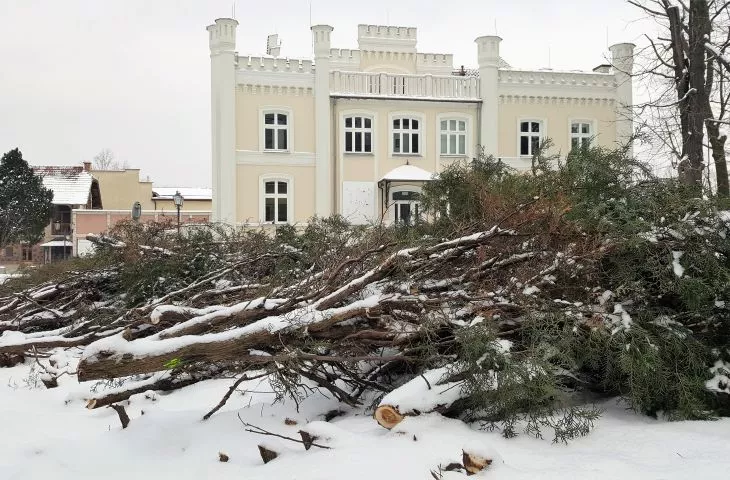Traditionally, the end of the year is a time for taking stock. So let's return to a topic that has recurred many times over the past twelve months, but nevertheless constantly arouses great emotions. It is about the presence of trees in the city, which is a topic of unrelenting discussion nationwide.
the great felling
The problem of declining trees in the city space and the arriving mass of concrete for new developments was described by Jan Mencel in a report on the activist shtick Betonoza. How Polish cities are being destroyed. This problem is raised by activists, but also by ordinary residents of cities that are being stormed by concretosis. An example of this is the case of100-year-old Katowice chestnut trees from a few days ago, which were illegally cut down on Raciborska Street by Activ Investment, a company building the Nova Mikołowska housing development. The scandalous felling has been reported to the police, and a notice to the prosecutor's office is also being prepared by the City Council, as the chestnut trees were growing not on the construction site, but on a city plot. According to the developer, the roots of the trees were damaged during the work, hence they had to be removed immediately to prevent them from threatening safety by falling onto the sidewalk or street. However, this is not an argument, because without the required approvals, in this case from the provincial marshal, or as a result of an exception, such as an emergency action with the participation of the relevant services, it is not possible to carry out the cutting. Another example is the high-profile case of cutting about 500 trees and about 40,000 shrubs along the Vistula River in Warsaw. The city planned the cutting for the purpose of building a flood barrier and infrastructure projects, but it was blocked by activists with the support of district councilors. They argued that, of course, protecting the residents of Bialoleka's Praga district and the animals of the Warsaw Zoo from flooding is unquestionably important, but on the other hand, there has been no flood threat at this location for nearly 20 years. On the other hand, according to officials, the felling would not significantly affect the area, which, I would emphasize, is part of the Natura 2000 area, a program that has protected certain types of natural habitats and species within the European Union since 2004. What's more, officials had no data on the species of trees and animals that would be annihilated as a result of the felling. On the one hand, we are dealing with the desire to protect the animals living in the zoo, while on the other hand we are depriving the animals living in the Vistula River area of their homes and, to a large extent, their lives. After all, you can't talk about protecting the lives of animals without protecting their habitats.
protection and education
This kind of situation can be seen as a model example of misunderstanding on the line - urban wildlife and residents versus investors. And despite the fact that there is a general awareness of ecology and the necessity of green spaces in cities, as well as positive trends that are standard in Western Europe, i.e. the creation of garden cities or city-parks, this does not significantly affect ad hoc measures to prevent the depletion of trees. One of the reasons for this is sometimes the decisions of officials who, not so much out of ill-will, but because of a lack of a deeper analysis of the problem, give permission for the removal of trees, or completely ill-considered, excessive pruning of branches, affecting their condition and development. As a result of this attitude, civic budget projects are being developed, but there are still not enough of them (this is, for example, the Warsaw city budget projects submitted by the Capital Society for the Protection of Birds since 2017, dealing with both birds and their habitats in Saska Kępa and Skaryszewski Park). They concern not only the protection of nature, but also the education of officials or residents by arborists invited to the project, as well as naturalists. As it turned out, residents want trees, appreciate trees and do not allow their removal, as these projects are implemented year after year with the support of the local community.
culture and nature
Activism and residents' activities, knowledge of the possibilities offered by the civic budget and, above all, education are very important tools in opposing logging. But what is the structural origin of this outrageous approach to the city's space, which is, after all, common to all? Let me go back to Betonoza, cited at the beginning, where we come across information about a certain opportunistic aversion to trees in a historical context, stemming from the post-PR trauma of ugly, chaotically developed cities. Trees removed in the name of absurd concrete harmony and new developments have fallen victim to this trauma. It's not just about aesthetics, but also a whole range of benefits, such as air purification with an effectiveness of up to 75% (according to the Energy Market Information Center -100 trees remove 454 kg of pollutants per year, including 181 kg of ozone and 136 kg of particulate pollutants), improvement of microclimate, temperature reduction, water absorption or noise attenuation. therefore, going with the times, the aspiration should not be dead blocks of concrete, but a pulsating, living fabric of the city composed of a hybrid of culture and nature. Only such a vision has a future.















